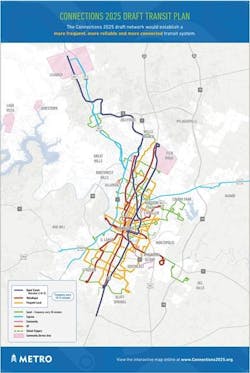After a year-long process involving an in-depth, analysis of its entire bus network by staff and a team of independent transportation experts, Capital Metro has presented its board with a 10-year draft transit plan that would nearly triple existing frequent routes, and significantly increase reliability and connections for riders.
The draft plan, called Connections 2025, would take Capital Metro in a new direction, increasing the number of high-frequency routes from 6 to 17, and upping frequency on many of its services to every 15-minutes or less. The plan also calls for doubling the number of MetroRapid routes and increasing frequency on that service to every 7 to 10 minutes during peak travel times.
More east-west connections would also be added, as well as more Express service on MoPac Express lanes, and on-demand circulator service for shorter distance travel in denser neighborhoods.
“There are some big ideas in the proposal,” said Capital Metro President/CEO Linda Watson, “many of which we received from the community. If approved, this plan would improve the design of our bus system and help us serve our riders better with far greater frequency and many more options.”
Building out the frequent service network as recommended would put over half a million people within a half-mile of a frequent bus route. Four out of five current riders would have better access to transit service overall.
As proposed, the improvements would combine to give riders six different service options:
- Rapid Transit – Frequent MetroRail or bus service with dedicated right-of-way along regional corridors, including bus service operating on future I-35 Express Lanes with in-line stations. Frequency: 15 minutes.
- MetroRapid – Rapid bus service along four major corridors. Frequency: 7 to 10 minutes.
- Frequent Local – Reliably convenient service throughout the Capital Metro service area. Frequency: 15 minutes.
- Local – Bus service connecting most neighborhoods to the High-Frequency Route Network and major destinations. Frequency: 30 minutes.
- Express – Peak commuter service connecting Park & Rides to key destinations.
- Community – Short-distance circulator routes serving specific communities.
Said Watson, “Creating practical, sustainable and immediate solutions are absolutely vital to improving mobility in our region, which we know is a top concern for people. We ultimately need a system that works for the majority of our riders, and the improvements recommended in this plan would create a more useable and effective system.”
Watson noted that the plan also recommends implementing a simplified fare structure to create an easier-to-navigate system that makes transferring easier and faster as passengers move across town. This would mean eliminating the current Premium fare, which includes MetroRapid and Flyer routes, and folding these services into the Local base fare.
The plan also addresses the region’s growing population centers, such as Mueller, The Domain, Seaholm and the future Plaza Saltillo development, by proposing new circulator services in these population centers that would offer connections around the centers and to the frequent network.
Frequency, reliability and better connections were the attributes mentioned most often in the feedback the agency received during several months of public input this year.
“We heard the public loud and clear and, as a result, the team has developed a plan that responds directly to that feedback,” said Watson.
For more than a year, the agency and its consultant, Transportation Management Design, immersed themselves in a new approach designed to deliver a 10-year service plan that would act as a road map for how to support the region’s transportation needs.
Capital Metro and TMD performed an in-depth market and service analysis to develop short- (1–10 years) and long-range (10+ years) recommendations to improve the network.
The team considered data from the agency’s own recent “origins and destinations” study, and also population and employment densities both now and in the next 10 to 20 years, and what types of best practices have been developed and are now in use by other cities.
The draft plan uses those best practices and also design standards, which call for consolidating corridors with duplicative service to reinvest in frequency—the most common request the agency received. Even with some less-efficient routes and segments eliminated, Capital Metro would retain service within a quarter mile, or a 5-minute walk, for more than 98 percent of riders.
A recent report by TransitCenter cites concentrating development around transit corridors, and improving walkable neighborhoods and frequency as the best methods to make public transit more useful for more people. Increased utility and convenience typically boost ridership and customer satisfaction.
The changes recommended in the Connections 2025 draft plan would be implemented in phases over the next 10 years. Capital Metro is proposing the first phase of changes in January 2017, utilizing the MoPac Express Lanes for Routes 982, 985 and 987; the addition of two new routes, 980 and 981; and the discontinuation of Route 983, due to redundancy of service.
The agency conducts an in-depth study of its bus system every five years. In 2010, the study resulted in the formation of MetroRapid, the addition of transit-priority lanes downtown, and the creation of the High-Frequency Route Network, which has proved to be very popular with riders.
More efficient, higher-frequency transit networks can play an important role in mitigating commuter congestion. Central Texas is projected to see a population increase of 20-29 percent by 2025 and 45-80 percent by 2040.




